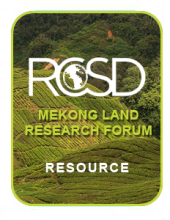Land Library
Welcome to the Land Portal Library. Explore our vast collection of open-access resources (over 74,000) including reports, journal articles, research papers, peer-reviewed publications, legal documents, videos and much more.
/ library resources
Showing items 109 through 117 of 501.ABSTRACTED FROM INTRODUCTION: This report explores the relationships between land tenure security and food security in Laos, with comparison to other developing countries.
Environmental governance in the context of climate change and land use is examined with the aim of specifying the conditions under which the incorporation of effective public participation in the governance process can be achieved.
In 2012, the Government of Myanmar passed the Farmland Law and the Vacant, Fallow, Virgin Land Law, with an aim to increase investment in land through the formalization of a land market.
The Lao Land and Forest Allocation Policy (LFAP) was intended to provide clearer property rights for swidden farmers living in mountainous areas. These lands are legally defined as “State” forests but are under various forms of customary tenure.
Over the past decade, Laos has experienced a land rush by foreign investors seeking to gain large tracts of land for hydropower, mining, and plantation projects.
The government of the Lao People’s Democratic Republic has made great efforts to halt the rapid decline in forest cover by implementing different policy measures, which include measures: to address the causes of the decline in forest cover; to sustainably manage natural forests; and to regenerate
Thirty years after Cambodia’s ‘democratization’ by the United Nations Transitional Authority (UNTAC), the transition to a market-based economy is raging at full steam.
Scholars have produced valuable insights on the question of recent “land grabbing” in the global South. They have, however, insufficiently studied the issue from below, particularly from the point of view of a crucial group in the land conundrum: the rural youth.
In Laos land concessions have increased dramatically over the last decade. To provide a window into the concessions landscape, we conducted a nationwide inventory between 2007 and 2011.

